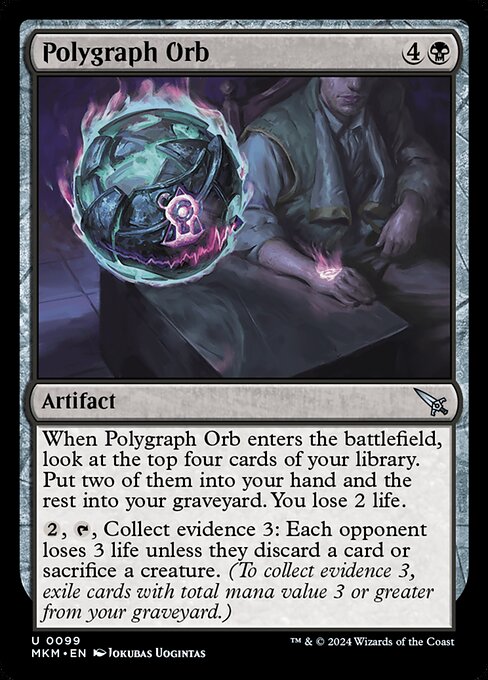
Image courtesy of Scryfall.com
Polygraph Orb in Limited: Draft and Sealed Performance
In the shadowy corridors of Murders at Karlov Manor, Polygraph Orb asks you to weigh your appetite for information against your life total. This black-aligned artifact from a gothic mansion-set era arrives with a five-mana commitment ({4}{B}) and a handmade decision: you glimpse the top four cards, pick two to keep, and send the rest to the graveyard, all while taking a small life toll. It’s the kind of design that says, "Yeah, you want options—now decide what to discard, and live with the consequences." The payoff is consistent: you gain two fresh cards on entry, and you seed your graveyard with answers or fuel for later, setting up late-game plays that can outgrind stubborn opponents. 🧙♂️🔥
What Polygraph Orb does
- Enter the battlefield: Look at the top four cards of your library. Put two of them into your hand and the rest into your graveyard. You lose 2 life.
- Activated ability: Pay {2} and tap to activate Collect evidence 3. Each opponent loses 3 life unless they discard a card or sacrifice a creature. To collect evidence 3, exile cards with total mana value 3 or greater from your graveyard.
The two-for-one card selection is a real edge in limited, where scavenging a couple of strong options off the top can define your early-game plan. The life loss is a cost, but in the draft you’ll often find ways to stabilize—removal, blockers, and life-gain shenanigans populate most black-heavy builds. And that Collect evidence 3 mode? It’s the match-ender you pull when you feel the wheel turning in your favor. If you can set up the graveyard with enough mana-value resources, that final swing can be brutal for opponents who rely on staying at parity. ⚔️
Draft considerations: sequencing, curve, and pick order
Polygraph Orb sits at a respectable five mana, a slot that often deserves a second look in a black-dominated pool. In a vacuum, the early draw is excellent—finding two solid cards from four options accelerates your plan while accelerating your opponent’s anxiety. In a multi-player pre-release format, you’ll notice the double-edged nature: you boost your hand size, but you also fill your graveyard to the brim with potentially overkill fodder for your late-game plays. As you draft, prioritize consistency—if you’re seeing reliable black removal or resilient blockers, Polygraph Orb becomes a natural anchor for the deck’s mid-to-late-game plan. And yes, you’ll want to keep an eye on your life total, because those two life losses add up in a crowded format, especially against aggressive starts. 🧩
Sealed strategies: maximizing impact with limited cards
Sealed pools tend to be more generous, and Polygraph Orb rewards you for that breadth. In sealed, you’ll almost always want to lean into graveyard synergy—cards that can recur from the graveyard, or that leverage the exile-from-graveyard mechanic in the Collect evidence ability—to convert the Orb’s entry draw into a durable push. The life loss remains a factor, but with bigger pools of lands and removal, you can stabilize while your opponents juggle resource management. The Collect evidence 3 clause, while gate-kept by exiling from the graveyard, acts as a major finisher in the late game when your board is solid and you can threaten an uninterrupted life-pierce. This is the kind of card that shines when you’ve curated a plan around tempo, control, and incremental advantage. 🎴
Strategic tips and combos to consider
- Graveyard preparation: Think about loading your graveyard with 3+ mana-value pieces over a couple of turns so the exile clause for Collect evidence 3 can be satisfied later in the game. This isn’t a race that you win by rushing; it’s a race you win by planning for the long haul. 🧭
- Tempo vs. value: The 2-life hit is modest, but it’s not nothing in a tight matchup. If you’re angling for tempo, use the Orb’s early draw to pick removal or low-cost answers and tilt the game toward mid-range inevitability.
- Activation timing: Save Collect evidence 3 for moments when you can maximize life-loss pressure on opponents who rely on thinning their own life totals with discard or sacrificing creatures. The activation cost is modest, but the payoff can be game-ending if timed correctly. ⚔️
- Deck-building note: In black-centric pools, you’ll often find yourself building around removal, discard effects, and graveyard interactions. Polygraph Orb provides both card advantage and a pathway to a big finisher, making it a flexible centerpiece for a control-or-midrange strategy.
Set in the moody, candlelit world of Murders at Karlov Manor, Polygraph Orb is a perfect reflection of the set’s theme: information as currency, risk as currency, and the graveyard as a resource you only learn to respect with experience. The art, by Jokubas Uogintas, captures that hush-before-the-storm feeling—an artifact that promises revelation, delivered with a price. The rarity is uncommon, which makes it accessible enough to see multiple copies in a single draft, yet potent enough to warrant attention in sealed play. 💎
If you’re chasing physical goods that echo this vibe in the real world and you want to keep the MTG hobby close at hand, this product aligns with the aesthetic—clean, practical, and stylish enough to carry from table to commute. For a little gadget that complements your gaming setup, check out the featured product below. 🧙♂️
phone grip kickstand click on holder
More from our network
- https://crypto-acolytes.xyz/blog/post/unlocking-decentralized-trading-with-polkadot-parachains/
- https://crypto-acolytes.xyz/blog/post/nether-survival-guide-for-minecraft-essential-tips/
- https://crypto-acolytes.xyz/blog/post/preserving-pc-game-history-archiving-best-practices/
- https://blog.digital-vault.xyz/blog/post/digital-paper-for-nft-artwork-and-collections-a-practical-guide/
- https://transparent-paper.shop/blog/blog/post/transform-canva-projects-with-digital-paper-techniques/